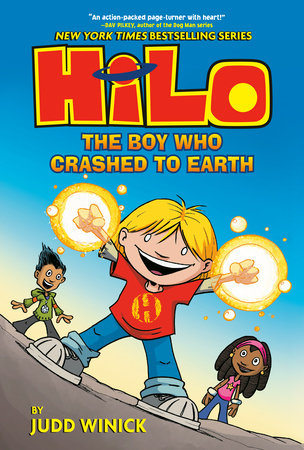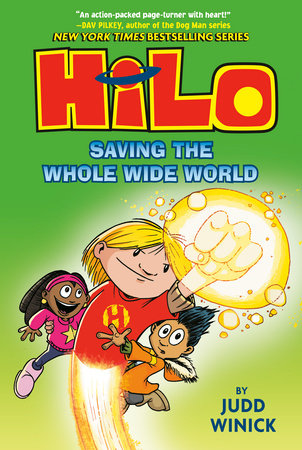Why Graphic Novels Are Storytelling Quicksand for Reluctant Readers
(In a Good Way)
by Judd Winick
Judd Winick is the author of Brightly’s Book Club for Kids pick Hilo: The Boy Who Crashed to Earth. Click here to learn more about the book, discover activities and tips for discussion inspired by Hilo, and join in on the reading fun.
I can make some pretty inappropriate comments about what comic books and graphics novels are. Here are a few:
“Comics are the gateway drug to reading.”
“They’re bear traps for reluctant readers.”
“Graphic novels are storytelling quicksand.”
These are icky ways to describe comics, but oddly, the comparisons have a ring of truth. There are many, many kids and even young adults who are “reluctant readers.” When it came to chapter books or books of prose, I was one of them.
I didn’t read a book of prose for pleasure until I was 13. It was The World According to Garp. I loved the movie, and I was curious about the book. Though complex, intense, and very emotional, I deeply enjoyed the book. Then it was maybe two more years before I read another book that I wasn’t assigned at school. But I was a reader. My folks never worried about my ability to read. I did very well in English; I wrote well; I had a vocabulary that, truth be told, bordered on precocious (a word I think I was using at age 11). This was because I read comics. I read them all the time. With those, I was an avid reader.
Some kids just take to reading in a big way — they find themselves lost in the story, and the words make images in their heads and they won’t put the book down until they find out how it ends. Some kids just fall in love with it. Some don’t. I think the kids in the “don’t” column would dig comics.
Comics and graphic novels are great for children and teens who may find reading prose daunting, the ones who look at those big books full of words and see a mountain. Or in some cases it may not be their ability to read; it just might be that nothing has turned their head yet. And you know what the secret is, the magic formula that makes comics easier to read than prose?
It’s all the pictures.
Let’s not pretend that it isn’t exactly what makes it easier, because it is. Pictures. But please don’t get snobby. Don’t assume comics are just longer picture books. Trust me, I enjoyed The Very Hungry Caterpillar as a wee one, but I’m sure I got more out of X-Men #137 a few years later.
Graphic novels allow the reluctant reader to slide into the story without as much of the heavy lifting as prose might require. They can see what’s going on, they can get ensnared in the story, and those “reader muscles” get a workout.
I think there might be a lot of unnecessary debate about whether comic books constitute “real” reading. You see the words inside the balloons above the characters? You have to read them. It’s reading. Do I think kids should only read comics? Heck, no. I think, like with food, one needs a balanced diet. But a kid who doesn’t dig reading hasn’t fallen in love with stories yet. And comics will get them falling in love. And then they’ll read prose. I promise.
“Comics are the gateway drug to reading.”
I created my book Hilo: The Boy Who Crashed to Earth with reluctant readers in mind. We begin without any words at all. Pages and pages of just running around, yelling, and general goofiness. The silence ends with a bit of mystery. Then … we get chatty.
“They’re bear traps for reluctant readers.”
Graphic novels are faster reads and provide that sense of accomplishment of finishing a book. They tackle as many complex themes as books of prose. And after reading a graphic novel, a kid is more apt to read a similar chapter book. Raina Telgemeier’s Smile can lead to Judy Blume’s Tales of a Fourth Grade Nothing. Jeff Smith’s Bone series can lead to The Lion, the Witch and the Wardrobe. Jarrett J. Krosoczka’s Lunch Lady series can lead to Roald Dahl’s Charlie and the Chocolate Factory.
Reading is reading. Even if there are pictures on every page.
-
Books in the Hilo Series:
-
Hilo: The Boy Who Crashed to Earth
Also available from:Hilo Book 2: Saving the Whole Wide World
Also available from:Hilo Book 3: The Great Big Boom
Also available from:
Judd Winick is an award-winning cartoonist and has scripted bestselling characters including Batman, Green Lantern, and Green Arrow and characters for “Justice League,” and “Star Wars.” He was the head writer on the Hulu network’s animated series “The Awesomes.” Judd also appeared as a cast member of MTV’s “The Real World: San Francisco” and is the author of the highly acclaimed graphic novel Pedro and Me, about his “Real World” roommate and friend, AIDS activist Pedro Zamora. Visit Judd and Hilo online at www.juddspillowfort.com and follow @JuddWinick on Twitter.



